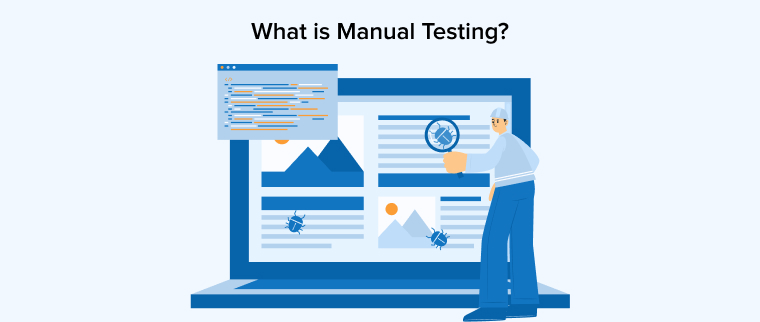
Software testing is the most important process in the software development lifecycle (SDLC). It is a process that is carried out by the testers to check, verify, and validate the user requirements of the developed product. Software testing also verifies that the product is bug-free and is created by keeping quality standards in mind. This domain is categorized into two areas: automated testing and manual testing. And which is better in automation testing vs manual testing is a question every techie has.
Automated testing is a process where the test cases are executed with the help of scripts and automation tools while on the other hand, manual test cases are executed manually. Both manual and automation testing are essential for checking the quality of the product but which to choose depends on the team of the software testing company.
To know more about manual testing vs automation testing, let’s go through this blog.
1. What is Automation Testing?

Automation Testing is one of the most widely used techniques for software testing. It is performed by using special automated testing tools that enable the testers to execute test cases. This is more flexible than manual testing as a tester won’t have to always sit in front of a computer to carefully monitor the software and execute the test steps. Basically, automation testing tools have the capability to enter test information into the System Under Test, compare expected and actual results, and generate detailed test reports. Software Test Automation demands considerable investments of money and resources.
Automation testing is an essential system testing type for a successive development cycle that will require the execution of the same test suite repeatedly. By using a test automation tool, the testers can record the test suite and also replay it if necessary. Once the automated tests are started, no human intervention is required. Because of this, the ROI of test automation has been improved.
Some of the major automated testing types are smoke testing, unit testing, functional testing, keyword testing, integration testing, regression testing, data-driven testing, performance testing, load testing, and the black box testing process.
2. When to Use Automation Testing?
We need to perform automation testing in several areas such as:
Performance testing: It determines the speed, stability functions, scalability, and characteristics of the system under test. As we all know, performance is examined by achieving response times and resource-utilization levels that meet all the objectives of performance for the project and are best suited for automation testing.
Load Testing: This type of testing is performed to verify that the application can handle the expected number of transactions and is able to verify the application’s behavior under peak and normal load conditions. It is well-suited for automated testing.
Regression testing: Repeated testing of an existing program that is already tested, after modification, to discover any faults that are not addressed as a result of the changes in the software being tested or unrelated software components. So we can say that regression testing is best suitable for automated testing as it is beyond the human capacity to perform tests on time.
3. What is Manual Testing?

Manual Testing is a simple testing process where the test cases are executed manually by the software testing team without using any test automation tools or techniques. The main aim of manual tests is to identify the issues, bugs, and defects in the application created by the software development team. For this, the testing team uses manual software testing techniques that can be helpful in accurately finding bugs in the software solution. If the team is manually testing a new application before it is automatically tested, the difficulty levels will increase. This is why it is advisable that the software is first automatically checked in some ways. But, manual testing is well suited for usability testing, exploratory testing or ad hoc testing. Basically, a combination of both manual and automated testing is required to offer secured software to the clients.
Some of the major types of manual testing are unit testing, black box testing, white box testing, system testing, integration testing, and acceptance testing.
4. When to Use Manual Testing?
Ad-hoc Testing: It is opposite to formal testing. In Adhoc testing, software testers aimlessly test the system without obeying any test design techniques and documents which are mostly performed with the knowledge of testers. They randomly test the app without depending on any test case or business requirement.
Exploratory Testing: This testing method is performed by domain experts and is conducted by exploring the app’s functionalities without knowing the requirements.
Usability Testing: To demonstrate whether the software is user-friendly or not because the user must use the software comfortably. It aims to check whether the end user can understand and operate the application easily or not.
5. Automation Testing Vs Manual Testing: Tabular Form
| Parameters | Automation Testing | Manual Testing |
|---|---|---|
| Definition | Automation Testing is a process that uses automation tools for test case execution. | Manual testing is a process where test cases are executed manually. |
| Initial Investment | In automation testing, the initial investment is higher but the ROI is better in the long run. | In manual testing, the initial investment is comparatively lower and the ROI is also lower. |
| Processing Time | The processing time in automated testing is significantly faster. | Manual testing is a time-consuming process. |
| Reliability | The testing method here is reliable as it is performed by software tools and scripts. | The testing process here isn’t accurate as there are chances of human errors. |
| Investment | Here investment is required for software testing tools and engineers. | Here investment is required only for human resources. |
| Human Observation | There is no involvement of human observation in automated testing. | In manual testing, human observation is necessary. |
| Test Report Visibility | All stakeholders can log in to the system and check the test reports generated by the automation testing approach. | The test reports in manual testing are generally recorded in Excel and aren’t readily available. |
| Cost-Effective | It is not cost-effective for low-volume regression. | It is not cost-effective for high volume regression. |
6. Automated Testing Pros and Cons
Here are the pros and cons of automated testing
6.1 Automated Testing Pros
Some of the major benefits of using automated software testing are –
- Automation testing is generally faster in test execution than manual testing.
- It is a more reliable, powerful, and versatile type of software testing.
- It is cheaper in comparison to manual testing in the long run.
- Automated testing is widely used for regression testing and it is reusable as the processes can be recorded.
- With automation tools available in the market, there is no need for human intervention required and the test scripts can be run without human resources.
- Automated testing helps in increasing the test execution and coverage time.
6.2 Automated Testing Cons
There are some cons when it comes to automated testing and they are –
- Automated testing is recommended only for products that are stable.
- It comes with very expensive tools for usability testing and the performance testing process.
- Automation testing itself is a very costly process.
- It has some limitations like getting visual aspects of User Interface like color, fonts, sizes, etc, and handling captcha.
- The maintenance cost is also high with automated testing as the cases need to be stored for future use.
7. Why Use Automation Testing Over Manual Testing?
We prefer automation testing over manual testing because of the following reasons,
- When it comes to the parallel testing process, automation is the best choice.
- Handling repetitive and time-consuming tasks is one of the benefits of automation tests.
- Automation testing is able to do non-functional testing like performance testing, load testing, and stress testing.
- There are no chances of human errors in automated testing.
8. Manual Testing Pros and Cons
Here are the pros and cons of Manual Testing
8.1 Manual Testing Pros
Some of the major benefits of using manual software testing are –
- Manual testing is a process that the testers carry out on all kinds of applications.
- When there is a newly designed test case, mostly manual testing is executed.
- Manual testing is preferred for short-life cycle products.
- Before the application goes through the automated testing process, it must be manually tested.
- Generally, manual testing is preferred more because it is cheaper in terms of initial investments in comparison to automation testing.
- Manual testing enables the testers to do ad-hoc testing.
- It requires less expense and time to begin productive manual testing.
8.2 Manual Testing Cons
There are some cons when it comes to manual testing and they are –
- In the long run, manual testing is considered more expensive than automation.
- Manual testing is a time-consuming process, especially when it comes to regression testing.
- In comparison to automated testing, a manual test is less reliable as it is conducted by humans.
9. Why Use Manual Testing Over Automation Testing?
We prefer manual testing over automation testing because of the following reasons,
- When it comes to testing the project from its initial development stage, manual testing is the best approach.
- For short-term projects, manual testing can show wonders and offer a successful software project.
- Manual testing is used when UI is being tested.
- For ad-hoc and exploratory testing, the manual method needs to be performed.
10. Conclusion
As seen in this blog, both manual and automation testing processes are essential when it comes to checking the software and making it bug-free for the end users. The real value of both these testing types comes out when the right type of testing is applied. This is why understanding the difference between manual testing and automation testing is necessary for the QA & testing team. After understanding the testing types and their pros & cons, the testing team of a software development company can decide which type of testing is required for that particular project.






Comments
Leave a message...